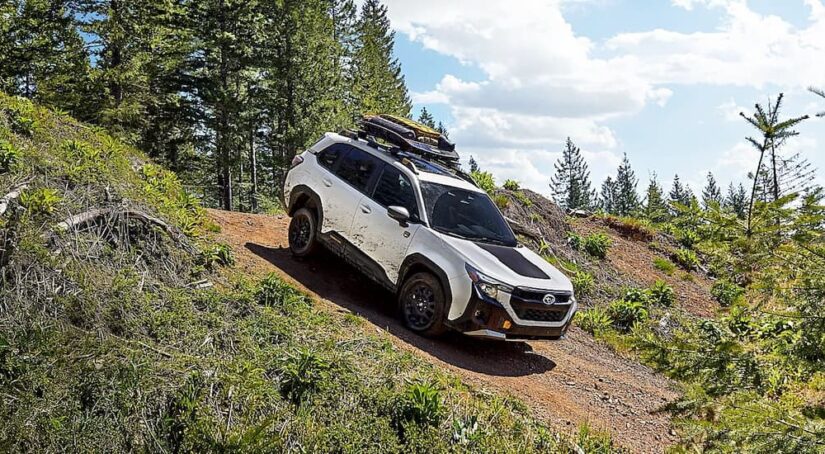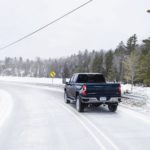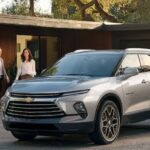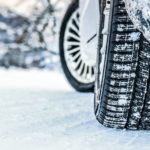There are plenty of reasons to look forward to winter, from reconnecting with family over the holidays to enjoying a warm cup of cocoa, ice skating, and ringing in the New Year with friends. That said, there is one aspect of the season that most people tend to dread: the icy, snowy roads that can make driving such a hassle. While it’s easy to get intimidated by winter weather, it all comes down to choosing the right tool for the job. Certain vehicles tend to fare well in tough conditions, while others can turn your daily drive into a white-knuckle experience. Most pickup trucks, especially those with 4WD, tend to excel in cold conditions thanks to their heavier bodies, larger wheels, and superior ground clearance, but what about cars and SUVs? We’ve shoveled through all of the 2026 models to provide our readers with three of the best options for 2026, ranging from a renowned compact crossover to a family-friendly three-row SUV and a sporty, affordable sedan.
2026 Subaru Forester
The question wasn’t whether to include a Subaru on our list, but which model to mention. The Japanese brand has become the go-to option for adventure-seekers thanks to its standard full-time AWD system and unique Boxer engine, which both make the company’s cars and SUVs particularly well-suited to the rigors of winter driving. We’ve settled on the compact Forester crossover, which is notable for recently gaining a new hybrid option with the introduction of the 2025 model. The gas-powered version provides drivers with 180 hp, while the hybrid delivers 194 hp thanks to an integrated electric motor. The Forester’s Boxer engine is another important aspect of the SUV’s foul-weather performance due to its flat design and horizontally opposed positions. This approach yields a compact engine that can be mounted lower in the chassis, providing the Forester with a low center of gravity that enhances stability and handling in slippery conditions.
Pure performance isn’t the be-all, end-all when it comes to picking a snow-worthy model. The Forester offers an above-average 8.7 inches of ground clearance, which is sure to come in handy when you’re trying to prevent the front bumper from becoming an impromptu snowplow. The crossover also features Subaru’s full EyeSight suite of camera-based driver-assistance features, including automated emergency braking, lane-departure warning with lane-keeping assist, and standard adaptive cruise control. Additionally, it comes with a rearview camera washer that prevents snow, ice, or caked-on road salt from obscuring your vision. The Premium trim gains all the comfort and convenience features that can make a significant difference on a cold winter morning, including a windshield wiper de-icer, heated front seats, and heated outboard mirrors.
The Forester’s Symmetrical AWD system is obviously the star of the show, allowing all drivers to enjoy full-time AWD that provides consistent 50/50 power distribution between the front and rear axles. The fact that all Subaru models, aside from the sporty BRZ, are designed with an AWD powertrain in mind gives the Forester another clear advantage. Instead of trying to squeeze an AWD system into an existing model, Subaru crafts every vehicle to accommodate four-wheel power from the very beginning. The Symmetrical AWD improves traction, reduces oversteer and understeer, and features a relatively simple design that leads to long-term durability and lower repair costs.
2026 Mazda 3
While SUVs and pickups excel in snowy scenarios, there are also a few cars that know how to handle the white stuff. The Mazda 3 has long been known for its fun, engaging ride, stylish design, and affordability, but few drivers realize that the compact can also mush with the best of them thanks to its advanced i-ACTIV AWD system. Available on half of the Mazda 3’s 2026 lineup, i-ACTIV AWD sets itself apart from the crowd thanks to its predictive, proactive approach to torque distribution. While many other AWD systems are only designed to engage once slippage has already occurred, the Mazda 3 utilizes a complex array of 27 sensors to monitor up to 200 individual data points continuously. I-ACTIV AWD can account for everything from driver inputs and road conditions to current temperature and weather, providing a precise mix of power between the front and rear axles. This marks a significant improvement over traditional reactive design, enabling drivers to hit the road with confidence in even the toughest conditions.
The i-ACTIV AWD system is just half of the story when it comes to the Mazda 3’s winter driving resume. Since 2019, the Mazda 3 has offered a software-based handling and stability control system dubbed G-Vectoring Control Plus (GVC+). The chassis control system works in tandem with i-ACTIV AWD to ensure a safe, stable, and predictable ride by precisely doling out engine torque when and where it’s needed most. When you start to turn into a corner, GVC+ temporarily reduces torque to slow the vehicle and allow the Mazda 3’s weight to shift to the front wheels for improved traction and a more linear steering response. As you begin to exit the corner, GVC+ ups the torque and subtly applies the brakes to the inner wheels to improve stability and straighten out the vehicle. It might sound a little technical, but the benefits of i-ACTIV AWD and GVC+ will quickly become evident when the thermometer begins to drop.
The Mazda 3 is available as either a sedan or hatchback and comes with your choice of I-4 engines. It all starts with the standard 2.5L, 186-hp model, but if you really want to embrace the Mazda 3’s performance-inspired ethos, there’s just no substitute for the turbocharged 2.5L option. Capable of producing 250 hp, the turbocharged engine comes standard with i-ACTIV AWD and allows the Mazda 3 to post a blistering zero-to-60-mph time of just 5.6 seconds. That’s good enough to lead the non-luxury end of the compact class by a wide margin and provide drivers with a perfect excuse to test their limits in drier, warmer conditions. The Mazda 3 also includes the expected complement of i-ACTIVSENSE advanced driver assistance systems (ADAS), as well as some crucial comfort-enhancing winter technologies, such as heated front seats, rain-sensing wipers, a dual-zone automatic climate control system, a heated steering wheel, and more.
2026 Chevy Tahoe
When a vehicle is named after a famous alpine lake, its ability to deal with snowy winter weather can never be treated as an afterthought. The full-size Chevy Tahoe SUV is easily the largest model on our list, and arguably the most practical and capable thanks to a robust 4WD system, three-row design, and body-on-frame construction. While all of these features deserve a closer look, we can’t skip over the Tahoe’s performance potential. The SUV, based on one of the country’s best-selling pickups, the Chevy Silverado 1500, is available with two powerful V8 engines or an optional turbo-diesel that offers an unbeatable mix of efficiency and torque. The standard engine is anything but standard, with Chevy gracing the Tahoe with a 5.3L V8 that can produce up to 355 hp and boasts the best towing ability of the bunch with 8,400 lbs of raw pulling power. The optional 6.2L V8 offers ample power to match its above-average displacement, reaching a maximum of 433 hp when properly equipped. Best of all, upgrading to the larger engine won’t significantly increase your fuel costs, as the 6.2L mill only loses a single MPG in 4WD form compared to the 5.3L design. Finally, there’s the 3.0L I-6 turbodiesel, which can be added to every time and provides 22 MPG combined, plus all the low-end power you’ll need to conquer slick winter roads and stubborn snowbanks with 495 lb-ft of torque.
Every 2026 Tahoe trim is available with 4WD, but if you’re in the market for a ready-made winter ride that can double as an off-road adventure rig in the warmer months, look no further than the Z71. The Z71 equips the Tahoe with a long list of heavy-duty off-road equipment that’s designed to improve your chances of success in winter driving. The trim’s standard 4WD system features a two-speed transfer case with low-range gearing, which enhances wheel torque to help the Tahoe navigate through dense snow or other loose surfaces. The Z71 also comes standard with 20-inch wheels, all-terrain tires, and red tow hooks that are bound to prove useful if you find yourself mired in a particularly deep snowbank. Hill Descent Control (HDC) really seals the deal, acting like a specialized form of cruise control that automatically takes over the braking duties to let the Tahoe move at a safe speed, allowing the driver to focus on navigating the road ahead.
If you really want to up the Tahoe Z71’s performance in off-road conditions or snowy surfaces, the Z71 Off-Road package throws an electronic limited-slip rear differential, adaptive air suspension, and magnetically controlled shock absorbers into the mix for good measure. Like most of the trim ladder, the Z71 can also be had with a Comfort package that’ll create a warm, cozy cabin that’ll almost have you looking forward to your morning commute in mid-January thanks to its heated, power-folding, and auto-dimming mirrors, heated steering wheel, and heated second-row outboard seats. The Tahoe also features 7.9 inches of ground clearance, rain-sensing wipers, plenty of modern ADAS, and a remote start feature that’ll allow you to warm up the cabin from the comfort of your kitchen table.
Stay Frosty
Choosing the right vehicle can go a long way towards improving your winter driving experience by giving you a newfound sense of confidence and security when you’re behind the wheel. A good 4WD or AWD system might get you off to a good start, but advanced traction control systems, ADAS, and comfort and convenience-focused technology like heated seats, mirrors, and remote starters can make those colder months a little easier to endure. It’s also important to be aware of the risks that come with winter driving and to prepare accordingly. If you live in an area that regularly experiences harsh winter weather, you should take a little time to create an emergency kit in case you find yourself stranded in a snowbank or mired in a deep drift on the side of the road. An ice scraper and snow brush are the bare minimum in terms of gear. Drivers should remember to pack an emergency blanket, a spare set of warm winter clothes, a small shovel, the ubiquitous jumper cables, a battery pack, and sand or kitty litter that can be used to gain a little extra traction in low-friction environs. With a little planning and the proper vehicle, there’s little risk of Old Man Winter ruining your next cold-weather excursion.





